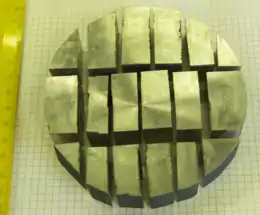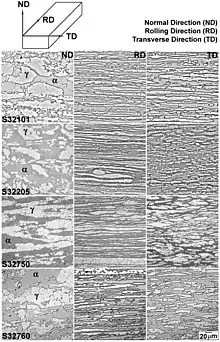Duplex stainless steel
Duplex stainless steels[1][2][3][4][5] are a family of stainless steels. These are called duplex (or austenitic-ferritic) grades because their metallurgical structure consists of two phases, austenite (face-centered cubic lattice) and ferrite (body centered cubic lattice) in roughly equal proportions. They are designed to provide better corrosion resistance, particularly chloride stress corrosion and chloride pitting corrosion, and higher strength than standard austenitic stainless steels such as Type 304 or 316. The main differences in composition, when compared with an austenitic stainless steel is that the duplex steels have a higher chromium content, 20–28%; higher molybdenum, up to 5%; lower nickel, up to 9% and 0.05–0.50% nitrogen. Both the low nickel content and the high strength (enabling thinner sections to be used) give significant cost benefits. They are therefore used extensively in the offshore oil and gas industry for pipework systems, manifolds, risers, etc and in the petrochemical industry in the form of pipelines and pressure vessels. In addition to the improved corrosion resistance compared with the 300 series stainless steels duplex steels also have higher strength. For example, a Type 304 stainless steel has a 0.2% proof strength in the region of 280 N/mm2, a 22%Cr duplex stainless steel a minimum 0.2% proof strength of some 450 N/mm2 and a superduplex grade a minimum of 550 N/mm2.

Grades of duplex stainless steels

Duplex stainless steels are usually divided into three groups based on their pitting corrosion resistance, characterised by the pitting resistance equivalence number, PREN = %Cr + 3.3 %Mo + 16 %N.[6]
- Standard duplex (PREN range: 28–38)
- Typically Grade EN 1.4462 (also called 2205). It is typical of the mid-range of properties and is perhaps the most used today
- Super-duplex (PREN range: 38-45)
- Typically grade EN 1.4410 up to so-called hyper duplex grades (PREN: >45) developed later to meet specific demands of the oil and gas as well as those of the chemical industries. They offer a superior corrosion resistance and strength but are more difficult to process because the higher contents of Cr, Ni, Mo, N and even W promote the formation of intermetallic phases, which reduce drastically the impact resistance of the steel. Faulty processing will result in poor performance and users are advised to deal with reputable suppliers/processors.[7] Applications include deepwater offshore oil production.
- Lean duplex grades (PREN range: 22–27)
- Typically grade EN 1.4362, have been developed more recently for less demanding applications, particularly in the building and construction industry. Their corrosion resistance is closer to that of the standard austenitic grade EN 1.4401 (with a plus on resistance to stress corrosion cracking) and their mechanical properties are higher. This can be a great advantage when strength is important. This is the case in bridges, pressure vessels or tie bars.
Chemical compositions
Chemicals composition of grades from EN 10088-1 (2014) Standard are given in the table below:[8]
| Steel designation | Number | C, max. | Si | Mn | P, max. | S, max. | N | Cr | Cu | Mo | Ni | Other |
|---|---|---|---|---|---|---|---|---|---|---|---|---|
| X2CrNiN22-2 | 1.4062 | 0.03 | ≤1.00 | ≤2.00 | 0.04 | 0.010 | 0.16 to 0.28 | 21.5 to 24.0 | - | ≤0.45 | 1.00 to 2.90 | - |
| X2CrCuNiN23-2-2 | 1.4669 | 0.045 | ≤1.00 | 1.00 to 3.00 | 0.04 | 0.030 | 0.12 to 0.20 | 21.5 to 24.0 | 1.60 to 3.00 | ≤0.50 | 1.00 to 3.00 | - |
| X2CrNiMoSi18-5-3 | 1.4424 | 0.03 | 1.40 to 2.00 | 1.20 to 2.00 | 0.035 | 0.015 | 0.05 to 0.10 | 18.0 to 19.0 | - | 2.5 to 3.0 | 4.5 to 5.2 | - |
| X2CrNiN23-4 | 1.4362 | 0.03 | ≤1.00 | ≤2.00 | 0.035 | 0.015 | 0.05 to 0.20 | 22.0 to 24.5 | 0.10 to 0.60 | 0.10 to 0.60 | 3.5 to 5.5 | - |
| X2CrMnNiN21-5-1 | 1.4162 | 0.04 | ≤1.00 | 4.0 to 6.0 | 0.040 | 0.015 | 0.20 to 0.25 | 21.0 to 22.0 | 0.10 to 0.80 | 0.10 to 0.80 | 1.35 to 1.90 | - |
| X2CrMnNiMoN21-5-3 | 1.4482 | 0.03 | ≤1.00 | 4.0 to 6.0 | 0.035 | 0.030 | 0.05 to 0.20 | 19.5 to 21.5 | ≤1.00 | 0.10 to 0.60 | 1.50 to 3.50 | - |
| X2CrNiMoN22-5-3 | 1.4462 | 0.03 | ≤1.00 | ≤2.00 | 0.035 | 0.015 | 0.10 to 0.22 | 21.0 to 23.0 | - | 2.50 to 3.50 | 4.5 to 6.5 | - |
| X2CrNiMnMoCuN24-4-3-2 | 1.4662 | 0.03 | ≤0.70 | 2.5 to 4.0 | 0.035 | 0.005 | 0.20 to 0.30 | 23.0 to 25.0 | 0.10 to 0.80 | 1.00 to 2.00 | 3.0 to 4.5 | |
| X2CrNiMoCuN25-6-3 | 1.4507 | 0.03 | ≤0.70 | ≤2.00 | 0.035 | 0.015 | 0.20 to 0.30 | 24.0 to 26.0 | 1.00 to 2.50 | 3.0 to 4.0 | 6.0 to 8.0 | - |
| X3CrNiMoN27-5-2 | 1.4460 | 0.05 | ≤1.00 | ≤2.00 | 0.035 | 0.015 | 0.05 to 0.20 | 25.0 to 28.0 | - | 1.30 to 2.00 | 4.5 to 6.5 | - |
| X2CrNiMoN25-7-4 | 1.4410 | 0.03 | ≤1.00 | ≤2.00 | 0.035 | 0.015 | 0.24 to 0.35 | 24.0 to 26.0 | - | 3.0 to 4.5 | 6.0 to 8.0 | - |
| X2CrNiMoCuWN25-7-4 | 1.4501 | 0.03 | ≤1.00 | ≤1.00 | 0.035 | 0.015 | 0.20 to 0.30 | 24.0 to 26.0 | 0.50 to 1.00 | 3.0 to 4.0 | 6.0 to 8.0 | W 0.50 to 1.00 |
| X2CrNiMoN29-7-2 | 1.4477 | 0.03 | ≤0.50 | 0.80 to 1.50 | 0.030 | 0.015 | 0.30 to 0.40 | 28.0 to 30.0 | ≤0.80 | 1.50 to 2.60 | 5.8 to 7.5 | - |
| X2CrNiMoCoN28-8-5-1 | 1.4658 | 0.03 | ≤0.50 | ≤1.50 | 0.035 | 0.010 | 0.30 to 0.50 | 26.0 to 29.0 | ≤1.00 | 4.0 to 5.0 | 5.5 to 9.5 | Co 0.50 to 2.00 |
| X2CrNiCuN23-4 | 1.4655 | 0.03 | ≤1.00 | ≤2.00 | 0.035 | 0.015 | 0.05 to 0.20 | 22.0 to 24.0 | 1.00 to 3.00 | 0.10 to 0.60 | 3.5 to 5.5 | - |
Mechanical properties
Mechanical properties from European Standard EN 10088-3 (2014)[8] (for product thickness below 160 mm):
| 0.2% proof stress, min. (MPa) | Ultimate tensile strength (MPa) | Elongation, min. (%) | ||
|---|---|---|---|---|
| X2CrNiN23-4 | 1.4362 | 400 | 600 to 830 | 25 |
| X2CrNiMoN22-5-3 | 1.4462 | 450 | 650 to 880 | 25 |
| X3CrNiMoN27-5-2 | 1.4460 | 450 | 620 to 680 | 20 |
| X2CrNiN22-2 | 1.4062 | 380 | 650 to 900 | 30 |
| X2CrCuNiN23-2-2 | 1.4669 | 400 | 650 to 900 | 25 |
| X2CrNiMoSi18-5-3 | 1.4424 | 400 | 680 to 900 | 25 |
| X2CrMnNiN21-5-1 | 1.4162 | 400 | 650 to 900 | 25 |
| X2CrMnNiMoN21-5-3 | 1.4482 | 400 | 650 to 900 | 25 |
| X2CrNiMnMoCuN24-4-3-2 | 1.4662 | 450 | 650 to 900 | 25 |
| X2CrNiMoCuN25-6-3 | 1.4507 | 500 | 700 to 900 | 25 |
| X2CrNiMoN25-7-4 | 1.4410 | 530 | 730 to 930 | 25 |
| X2CrNiMoCuWN25-7-4 | 1.4501 | 530 | 730 to 930 | 25 |
| X2CrNiMoN29-7-2 | 1.4477 | 550 | 750 to 1000 | 25 |
| X2CrNiMoCoN28-8-5-1* | 1.4658 | 650 | 800 to 1000 | 25 |
*for thickness ≤ 5 mm
The minimum yield stress values are about twice as high as those of austenitic stainless steels.
Duplex grades are therefore attractive when mechanical properties at room temperature are important because they allow thinner sections.
Heat treatment[9]
| UNS № Grade | EN № | Hot forming temperature range | Minimum soaking temperature |
|---|---|---|---|
| S32304 | 1.4362 | 1150–950 °C | 980 °C |
| S32205 | 1.4462 | 1230–950 °C | 1040 °C |
| S32750 | 1.4410 | 1235–1025 °C | 1050 °C |
| S32520 | 1.4507 | 1230–1000 °C | 1080 °C |
| S32760 | 1.4501 | 1230–1000 °C | 1100 °C |
Duplex stainless steel grades must be cooled as quickly as possible to room temperature after hot forming to avoid the precipitation of intermetallic phases (Sigma phase in particular) which drastically reduce the impact resistance at room temperature as well as the corrosion resistance..
Alloying elements Cr, Mo, W, Si increase the stability and the formation of intermetallic phases. Therefore super duplex grades have a higher hot working temperature range and require faster cooling rates than the lean duplex grades.
Applications of duplex stainless steels
Duplex stainless steels are usually selected for their high mechanical properties and good to very high corrosion resistance (particularly to stress corrosion cracking).
- Architecture
- Stockholm's waterfront building [10]
- Louvre Abu Dhabi [11]
- La Sagrada Familia [12]
- Infrastructure:
- Helix Bridge, Singapore [13]
- Cala Galdana bridge [14]
- sea walls, piers etc...
- tunnels,
- Oil and Gas:
- a wide range of equipment: flowlines, manifolds, risers, pumps, valves....[15]
- Pulp and Paper:
- digesters, pressure vessels, liquor tanks etc...[16]
- Chemical engineering:
- pressure vessels, heat exchangers, condensers, distillation columns, agitators, marine chemical tankers,....[17]
- Water:
- desalination plants, large tanks for water storage, waste water treatment [18]
- renewable energy: Biogas tanks
- Mobility: tramcars and bus frames, tank trucks, iron ore wagons [5]
- Engineering: pumps, valves, fittings, springs, etc...
References
- Peckner, Donald; Bernstein, I.M. (1977). "chapter 8". Handbook of Stainless Steels. McGraw Hill. ISBN 9780070491472.
- Lacombe, P.; Baroux, B.; Beranger, G. (1990). "chapter 18". Les Aciers Inoxydables. Les Editions de Physique. ISBN 2-86883-142-7.
- International Molybdenum Association (IMOA) (2014). Practical Guidelines for the fabrication of Duplex Stainless Steels (PDF). www.imoa.info. ISBN 978-1-907470-09-7.
- Charles, Jacques (2010). Proceedings of the Duplex Stainless Steel Conference, Beaune (2010). EDP Sciences, Paris. pp. 29–82.
- International Stainless Steel Forum (2020). "Duplex Stainless Steels" (PDF).
- Bristish Stainless Steel Association. "Calculation of Pitting Resistance Equivalent Number (PREN)". bssa.org.uk.
- "Knowledge center — Sandvik Materials Technology". www.materials.sandvik. Retrieved 2019-03-25.
- "The standard is available from BSI Shop".
- International Molybdenum Association (IMOA). "Hot forming and Heat Treatment of Duplex Stainless Steels" (PDF). www.imoa.info.
- Euro-Inox. "Innovative Facades in Stainless Steel". Euro-Inox Publication, Building series. 19. p. 34. ISBN 978-2-87997-372-2.
- International Molybdenum Association (2019). "Louvre Abu Dhabi: A rain of light". Moly Review (1).
- "Basilica de la Sagrada familia". Acero Inoxidable (82). Cedinox. June 2018.
- Steel Construction Institute (2012). "Helix Pedestrian Bridge".
- "Cala Galdana Bridge". Steel Construction Institute. 2010.
- Zuili, D (2010). "The use of stainless steels in oil & gas industry". Proceedings of the Duplex Stainless Steel Conference: 575.
- Chater, James (2007). "The pulp and paper industry turns to duplex" (PDF). Stainless steel world.
- Notten, G (1997). Application of Duplex Stainless Steel in the chemical process industry (PDF). 5th Duplex stainless steel world conference. Stainless Steel World.
- Directorate-General for Research and Innovation (2013). Duplex stainless steels in storage tanks. EU Publication. doi:10.2777/49448. ISBN 978-92-79-34576-0.